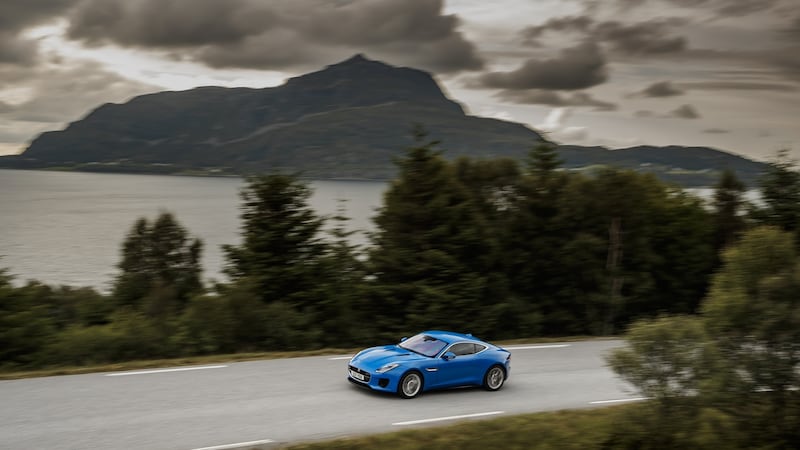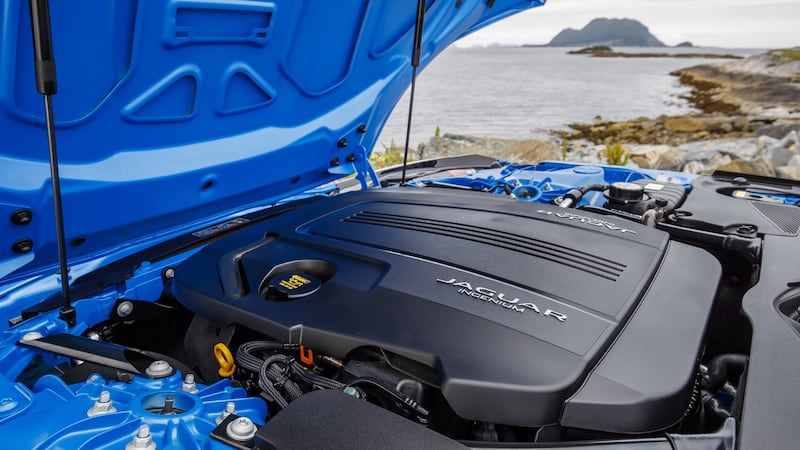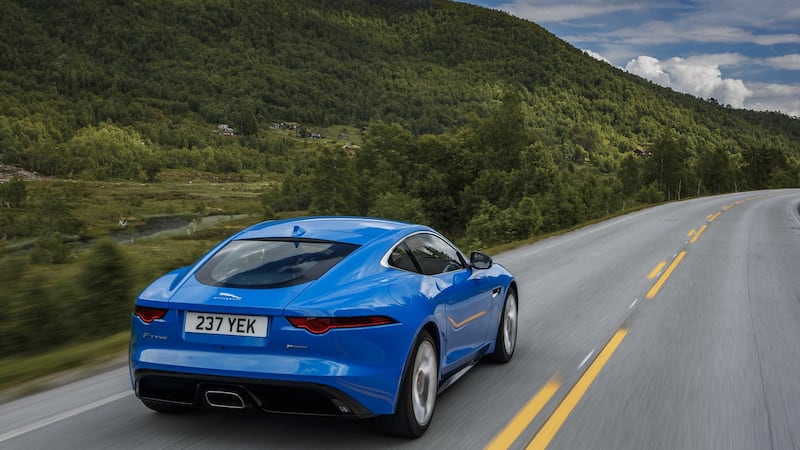The first time I ever drove a Jaguar F-Type sports car, I burst into helpless fits of the giggles. Every time I accelerated and pulled the paddle to summon up a gearchange, the supercharged V6 engine would fire unburned fuel down its hot exhaust, causing a cacophony that sounded like a philharmonic orchestra being fired from an artillery cannon. It was glorious, fatuous, hilarious all at once and the sheer sound of its engine became a major part of the F-Type's appeal.

Which is why this four-cylinder version of the F-Type is such a potentially dangerous car. Last year, Porsche decided to stick a new turbo flat-four engine into its Cayman and Boxster models, in place of the sonorous old flat-six. The reaction was acerbic, especially from Porsche-philes and professional critics who dubbed the new engine a disappointment because it just didn't sound as good as the old six. To my mind, those critics were rather missing the point of more power from a smaller engine, that could also crack 40mpg on a long run, and I even quite enjoyed the new Boxster's Subaru-esque soundtrack, but I was in the minority.
0 of 4
Approaching the new four-cylinder F-Type, though, I became rather nervous. Our test car, a hard-top coupe in a rather stunning colour called Ultra Blue, that looks as if it should be adorning the flanks of a pre-war racing Bugatti, looks every inch the true-blue F-Type. Low and curvy, with that priapic snout inciting all sorts of Freudian complications, the F-Type is still one of the most striking cars on the road.
Price sensitive
Cheaper than ever too, now. The new 'Ingenium' four-cylinder engine brings with it a massive falling the F-Type's Co2 emissions (all part of its mission, really) which, in Ireland, means a dramatic drop in price. In the UK, this four-pot F is a mere STG£3,000 cheaper than its V6 stablemate. Here at home, thanks to the vagaries of VRT, it's more like €30,000 - the four-cylinder model's prices will start from a mere €65,000 or thereabouts, right in the heart of the Porsche Cayman and Boxster price list.
Better yet, with Co2 emissions of 163g/km, this is a sexy, ground-hugging Jaguar that will now cost you a trifling (trifling if you can afford the asking price) €570 a year to tax. Or rather less than a ten-year old Ford Mondeo, in other words.

The engine that has wrought these changes is a 2.0-litre four-cylinder unit, with a cleverly close-coupled twin-scroll turbocharger and a clever electro-hydraulic camshaft system that can fiddle with the engine’s breathing to either summon extra power or squeeze out improved economy, depending on where you are and what you need. To go with that 163g/km Co2 figure, Jaguar also claims an impressive 39mpg average fuel economy figure. Those concerned that this cat is playing with clipped claws will be mollified by the impressive 300hp power output, and the 400Nm torque figure. This supposedly lesser F-Type will scramble to 100kmh in 5.7secs, and on to a top speed of 250kmh, which is realistically only good hot hatch pace, but still decently brisk.
Sound of value
Does it sound any good though? Actually, yes - not bad at all. OK, so there isn’t the violent musicality of the V6 or V8-engined F-Type models, but for a four-pot, it’s pretty good. There’s a gruff growl that rises to a rough-edged howl when you accelerate hard, and a delicious pop-pop from the exhaust when you change gear or back off the throttle. It’s also really very refined when cruising on a light throttle, so the F-Type remains a GT in which you’ll happily knock off long distances. Doubtless the Jaguaratti will take to Twitter to decry the loss of cylinders, the loss of volume, but make no mistake - this is an impressive engine.
The rest of the F-Type’s strengths remain intact. That gorgeous shape is identical to the V6 and V8 cars, bar the use of a single, central exhaust pipe, and different 18-inch alloy wheels. And it is delectable to drive.
Because the four-cylinder engine is some 52kg lighter than the V6, Jaguar has altered the spring rates and the suspension dampers, and tweaked the steering too. The result doesn’t feel dramatically different to the larger-engined cars, but you can sense a little more agility to the front end, and a little less likelihood of the rear-end snapping loose under throttle. This will make the four-pot F-Type less fun on track, but more useable on a wet, unfamiliar road, methinks. Either way, the steering feels delicious, and the retuned dampers mean that the ride is comfortable enough for cross-continental flits, should the mood take you. If nothing else, the longer fuel tank range of this more frugal engine means that you’ll spend less time in filling stations and more behind the wheel and that’s no bad thing - as soon as you trigger that pop-out door handle, and slip behind the wheel, the F-Type feels instantly like a car you never want to get out of.

Inside, there are very few changes. Slightly slimmer seats have liberated a touch more legroom, there’s an updated Touch Pro infotainment system and a new windscreen mounted camera that controls such systems as autonomous emergency braking, lane keeping steering, and a traffic sign monitor, and there’s a new driver drowsiness monitor too. Overall, the cabin looks a touch plain but it’s well built and the boot is a useable, if hardly cavernous, 310-litres.
Those worried that Jaguar would ruin the F-Type by trimming its cylinder count can rest easy - if anything, this 300hp model feels better than ever. That lower price point makes it more tempting than ever, and it looks far more exciting, more desirable than the Porsche Cayman. It’s lacks the ballistic performance and 64-channel sound of the bigger engines, but it’s still riotously good to drive, and a far more realistic prospect for many buyers now.
I may not be in fits of the giggles, this time, but I’m smiling from ear to ear all the same.

The lowdown: Jaguar F-Type Four-Cylinder 300ps
Price: as tested, €65,000 (TBC)
Power: 300hp
Torque: 400Nm
0-100km/h: 5.7 seconds
Top speed: 250km/h
Claimed economy: 39.2mpg (7.2 litres/100km).
CO2 emissions: 163g/km.
Motor tax: €570.
Verdict: Lacking in cylinders but lacking nothing in looks, performance, excitement. All that and it's €30,000 cheaper? Win-win.
















